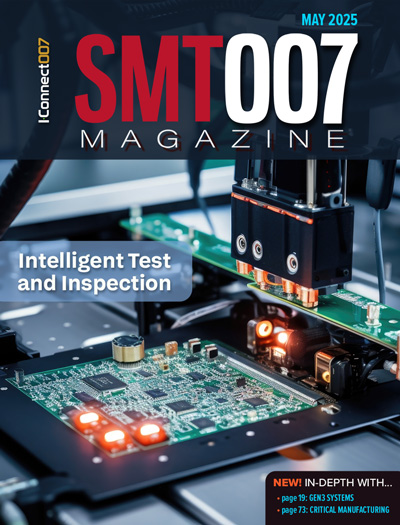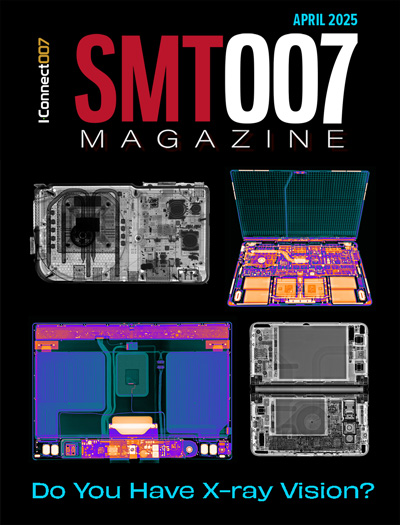-

- News
- Books
Featured Books
- smt007 Magazine
Latest Issues
Current Issue
Intelligent Test and Inspection
Are you ready to explore the cutting-edge advancements shaping the electronics manufacturing industry? The May 2025 issue of SMT007 Magazine is packed with insights, innovations, and expert perspectives that you won’t want to miss.

Do You Have X-ray Vision?
Has X-ray’s time finally come in electronics manufacturing? Join us in this issue of SMT007 Magazine, where we answer this question and others to bring more efficiency to your bottom line.

IPC APEX EXPO 2025: A Preview
It’s that time again. If you’re going to Anaheim for IPC APEX EXPO 2025, we’ll see you there. In the meantime, consider this issue of SMT007 Magazine to be your golden ticket to planning the show.
- Articles
- Columns
Search Console
- Links
- Media kit
||| MENU - smt007 Magazine
Intel, Ohio Supercomputer Center Double AI Processing Power with New HPC Cluster
February 20, 2024 | Intel CorporationEstimated reading time: 2 minutes
A collaboration including Intel, Dell Technologies, Nvidia and the Ohio Supercomputer Center (OSC), introduces Cardinal, a cutting-edge high-performance computing (HPC) cluster. Purpose-built to meet the increasing demand for HPC resources in Ohio across research, education and industry innovation, particularly in artificial intelligence (AI).
AI and machine learning are integral tools in scientific, engineering and biomedical fields for solving complex research inquiries. As these technologies continue to demonstrate efficacy, academic domains such as agricultural sciences, architecture and social studies are embracing their potential.
Cardinal is equipped with the hardware capable of meeting the demands of expanding AI workloads. In both capabilities and capacity, the new cluster will be a substantial upgrade from the system it will replace, the Owens Cluster launched in 2016.
The Cardinal Cluster is a heterogeneous system featuring Dell PowerEdge servers and the Intel® Xeon® CPU Max Series with high bandwidth memory (HBM) as the foundation to efficiently manage memory-bound HPC and AI workloads while fostering programmability, portability and ecosystem adoption. The system will have:
- 756 Max Series CPU 9470 processors, which will provide 39,312 total CPU cores.
- 128 gigabytes (GB) HBM2e and 512 GB of DDR5 memory per node.
With a single software stack and traditional programming models on the x86 base, the cluster will more than double OSC’s capabilities while addressing broadening use cases and allowing for easy adoption and deployment.
The system is also equipped with:
- Thirty-two nodes that will have 104 cores, 1 terabyte (TB) of memory and four Nvidia Hopper architecture-based H100 Tensor Core GPUs with 94 GB HBM2e memory interconnected by four NVLink connections.
- Nvidia Quantum-2 InfiniBand, which provides 400 gigabits per second (Gbps) of networking performance with low latency to deliver 500 petaflops of peak AI performance (FP8 Tensor Core, with sparsity) for large AI-driven scientific applications.
- Sixteen nodes that will have 104 cores, 128 GB HBM2e and 2 TB DDR5 memory for large symmetric multiprocessing (SMP) style jobs.
“The Intel Xeon CPU Max Series is an optimal choice for developing and implementing HPC and AI workloads, leveraging the most widely adopted AI frameworks and libraries,” said Ogi Brkic, vice president and general manager of Data Center AI Solutions product line at Intel. “The inherent heterogeneity of this system will empower OSC’s engineers, researchers and scientists, enabling them to fully exploit the doubled memory bandwidth performance it offers. We take pride in supporting OSC and our ecosystem with solutions that significantly expedite the analysis of existing and future data for their targeted focus areas.”
Suggested Items
SEMI Reports Typical Q1 2025 Semiconductor Seasonality with Potential for Atypical Shifts Due to Tariff Uncertainty
05/19/2025 | SEMIAccording to the Q1 2025 Semiconductor Manufacturing Monitor (SMM) Report released by SEMI in collaboration with TechInsights, the global semiconductor manufacturing industry entered 2025 with typical seasonal patterns.
NY CREATES, Fraunhofer Institutes Announce Joint Development Agreement to Advance Memory Devices at the 300mm Wafer Scale
05/16/2025 | NY CREATESNY CREATES and Fraunhofer IPMS announced at a signing ceremony a new Joint Development Agreement (JDA) to drive research and development focused on memory devices.
SMC Korea 2025 to Spotlight Next-Generation Memory and Materials Innovation amid AI Boom
05/13/2025 | SEMIThe Strategic Materials Conference (SMC) Korea 2025 is set to convene on May 14 at the Suwon Convention Center in Gyeonggi-do, South Korea, bringing together leading experts and innovators to highlight the critical role of materials innovation in addressing the performance, efficiency, and scalability requirements of AI-enabled semiconductor devices.
OKI Develops 124-Layer PCB Technology for Next-Generation AI Semiconductor Testing Equipment
04/28/2025 | BUSINESS WIREOKI Circuit Technology, the OKI Group printed circuit board (PCB) company, has successfully developed 124-layer PCB technology for wafer inspection equipment designed for next-generation high bandwidth memory, such as HBM mounted on AI semiconductors.
Micron Announces Business Unit Reorganization to Capitalize on AI Growth Across All Market Segments
04/23/2025 | MicronMicron Technology, Inc., a leader in innovative memory and storage solutions, announced a market segment-based reorganization of its business units to capitalize on the transformative growth driven by AI, from data centers to edge devices.


